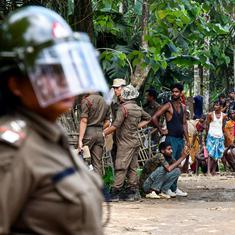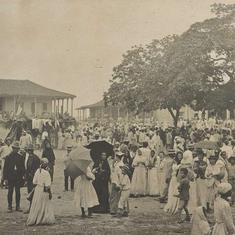I belong to the Santal indigenous community (as much as possible, I try to not use the word “tribe” for an “indigenous community”), from Purbi Singhbhum district in Jharkhand. I grew up in Moubhandar, in a semi-urban set-up, in the township of a central government enterprise engaged in mining, primarily, copper.
From childhood, I had been made aware by my family of my position as an Adivasi and how we Adivasis differ from those from the mainstream non-Adivasis, whom we called diku. My family made sure that I had learnt to speak Santali as my first language – which I did, alongside Hindi (from people and film songs), English (from school) and Bengali (from people and Bengali papers and magazines).
During long school holidays, I was taken to our ancestral house nearly 40 km away in a village in Chakulia, just a hop from the West Bengal border. There, in our predominantly Santal village, a space we shared with two other major communities, the Kamar (the blacksmith caste) and the Kunkal (the potter caste), I spent my holidays happily.

From my childhood in the mid-1980s till my pre-employment adulthood in the late-2000s, I saw our village home as a traditional, sturdy Santal house, built of mud and strong, ancient wood, brightly painted on the outside in shades of yellow and red, and on the inside in a blue so light it looked almost white, its sloping roof covered with red clay tiles. In the late-2000s, my father had a wing of our ancestral house pulled down and replaced with a new concrete building. Only the layout remained the same.
Reading about Santal houses in Gauri Bharat’s book, In Forest, Field and Factory: Adivasi Habitations through Twentieth-Century India, pulled me out of a stupor that came from being a mere complacent inheritor of a rich heritage.
Three decades of living in a Santal house in a Santal village and it had never occurred to me to ask: “Why do Santal houses not have windows on their outside walls?”
Bharat is an architect and teaches at CEPT University, Ahmedabad. Bharat’s book, according to its cover copy, aims to “[uncover] how and why Adivasi dwellings have changed” down the years/generations and it focuses rather primarily “on Santals, one of the largest Adivasi communities in eastern India, who are particularly renowned for precision and craftsmanship in domestic architecture and mural art.” This book does all that and more.
In the book’s online preview, the keywords that caught my attention were “Santal and Seraikela”. Santal, the community I belong to and Seraikela (I prefer to spell it Saraikela now), the district I am working in currently. Bharat’s research has almost entirely been in my home district of Purbi Singhbhum and Seraikela-Kharsawan. This prompted me to buy this book. That and a particular curiosity: “What is in this book that I do not know already?”
What I read was not only unexpected, it humbled me. The feeling of entitlement that came from seeing familiar names was instantly shoved out. In eight lucid and eye-opening chapters, Bharat lets her curiosity guide her and her readers.
Apart from writing about the traditional Santal architecture, Bharat puts those houses in the wide historical, social, religious and economic contexts of the community. This is a scholarly volume written with care and empathy, and – for me – reading this book let me realise not how much the author has come to know about our community but how much I had known about our community.

Who built cities?
The very first page of the Introduction, titled “Foregrounding Change”, is telling. I will quote an excerpt in which Bharat writes about Jamshedpur, the cosmopolitan, industrial city she grew up in:
“Jharkhand in eastern India is one of the oldest centres of industrialisation in South Asia while also being home to a large Adivasi population. The narrative of industrialisation has dominated life and history in this region and overshadowed the Adivasi hinterland that it developed within.
As a young person growing up in Jamshedpur, which is one of the largest iron and steel producing centres in south Jharkhand, I was largely oblivious to the presence of Adivasis in the city and beyond. I had heard of them of course, but they were almost abstract, living somewhere deep within unknown forests, far outside the modernity of the city.
Jamshedpur had, and continues to have, a very mixed population with diverse communities from all over India. I grew up in neighbourhoods with people from many different backgrounds, speaking many different languages. Most communities have cultural institutions as a marker of their presence within the city. Notable Adivasi institutions were, for the most part, missing. Except for weekly markets and a passing glance at crowds of Adivasi labourers outside factory gates, one did not encounter Adivasi culture and society within the public life of the city.”
In a society where religion and culture are often equated, it perhaps should not come as a surprise to see religious buildings also serving as social and cultural centres. It is normal to see urban spaces dotted by these religious-cum-cultural buildings.
Normal but one might ask: “Who builds these buildings? The temples, the mosques and the like? And someone from an Adivasi community might ask: And where is the religious or cultural space for Adivasis in an urban set-up?”
The answer to both these questions might lie in answering this – not who builds the city but who gets the city built. Who gets all this done, pays for all this to be done.
Do Adivasis build cities? Yes, they do. Are they not the ones mixing cement and water, the ones carrying mortar on their heads and climbing up scaffolding, the ones working amidst scalding tar fumes under the hot sun?
But do these Adivasis build these cities for themselves? Do they own these cities? No.
Let us accept this. Apart from being moneyed, people getting the cities built have two other traits:
- Most of them follow organised religion, and
- They call themselves the mainstream.
It is this mainstream who builds those temples, mosques, and gurdwaras too – their “cultural institutions as a marker of their presence” – within the cities. Adivasis – not moneyed, not mainstream, not followers of organised religion except those who have converted to Christianity – have no space within a urban space.
And even if Adivasis find their cultural or religious space within a city, that space might have been gifted or donated to the Adivasis by the same mainstream who were responsible for having that city built or who own that city. This move might be political or appear inclusive, but it is just a token, nevertheless.
In Jamshedpur, temples, mosques and gurdwaras are located so prominently they are landmarks – be it the Andhra Bhakta Sri Ram Mandiram in Bistupur, the Central Jama Masjid in Sakchi, the gurdwara on Kalimati Road, the Beldih Baptist Church in Circuit House Area, or the Parsee Fire Temple close to the Keenan Stadium.
But where are the jaher (jahira in Bharat’s book), the sacred groves of the Santal men and women who mill in and out of one of the world’s most well-known iron and steel factories, in all three shifts? Those jaher are on the outskirts of Jamshedpur, in villages where, perhaps, those Santals were pushed out when this city was being built.
In Moubhandar too, temples and churches are landmarks but the jaher is outside the township, by the bushes near the railway tracks, where industrial waste is dumped.

Among the many attractions of Jamshedpur is the Jubilee Park, right in the middle of the city. Owned and maintained by Tata Steel, the 200-acre Park was inspired by the Brindavan Gardens of Mysore and opened in 1958. A space so huge it makes me wonder how many jaher it could fit in. The Jubilee Park came up in 1958, decades after the iron and steel plant and Jamshedpur city. The religious/cultural centres of the mainstream too must have come up around the same time.
How many more decades before the city planners – of any city or town – realise that if a park can fit, there should be space to accommodate prominently the religious/cultural space of the non-mainstream people who built that city with their hard labour?
Perhaps the non-mainstream were kept out of urban spaces by design. Perhaps the mainstream was wary that the non-mainstream might interfere in matters of that urban space. Or, perhaps, the mainstream did not care about the non-mainstream at all or thought the non-mainstream to be unworthy of acknowledgement.
Something that Bharat hints when she writes:
“Over the years, I realised that the social invisibility of Adivasis or the perception of their primitiveness was not a personal shortcoming alone, but a much wider … construct that pervaded the popular perception of these communities in the urban centres of the region.”
Inside the ‘orak’
When Bharat writes about the orak – Santali for house – she does it with intimacy and fascination. She observes: “Santal houses were crafted and decorated in ways that visually distinguished them from those of other communities.”
In the chapter, “The Orak and its History”, Bharat notices, “The front walls of Santal houses are nearly always blank, with no openings except for the front door” – something that made me scurry for an answer.
Bharat explains: “Santals and other Adivasis in the region have a strong belief in witchcraft and…a palpable fear of outsiders casting an evil eye … the blank walls protect the interior space of the house from being exposed to an outsider’s gaze.”
I had never given the windowless outside walls of our own houses any thought before. I started enquiring among people I know after reading Bharat’s book.
Two reasons I heard:
- Protection from thieves, and
- Protection from magic.
Bharat traces the evolution of the orak from the kumbha, a simple, “shack-like structure” (I have grown up pronouncing it kumba) to a conglomeration of structures around a common, inner courtyard, the racha.
Bharat’s description of the racha gives it a personality of its own. The racha is a common space where the various rooms of an entire, bigger orak open into. It may have a chulha. Children may use it as a playing space, as I did in my childhood. It may be used for drying grains and washed clothes. Bharat’s acute observation stayed with me:
“In addition to the plastering of the racha [with cow dung], Santal women constantly strive to tidy the house by picking things off the floor and depositing them on higher surfaces such as the eaves of the sloping roofs. Nearly all objects in Santal houses are stored off the ground.”
I can vouch for this practice. In our village house, the tiled roof was home to brooms, shoes, wide bamboo trays on which jaanum bili (Indian jujubes) were spread for drying, bottles of pickled mangoes, bamboo baskets and clay pots, aluminium buckets for drawing water from the well, and even fishing nets.

This practice is ingrained in me too. I work and live in a place called Chandil, a smallish Jharkhand town with a village panchayat. I live in a rented, flat-like space. In smaller places – like Ghatsila, Chakulia and Chandil also Pakur, where I previously lived and worked before being transferred to Chandil – middle-class houses share a few features.
One of those is racks built into the walls – built at a height roughly two-thirds from the floor. Racks, not shelves. Just a single rack projecting out from the wall. The racks in my current home have the empty cartons of my fridge and microwave, plastic clotheslines, plastic bags I have been too lazy to discard, defunct ballpoint pens and also shredded receipts.
Another revelation
I was to face another revelation. In the chapter titled, “The Transformation of Domestic Art”, Bharat observes:
“The relationship between domestic art practices and identity is much more fluid in everyday life than the popular imagination around mural art would suggest. One site where this clearly plays out is in the making of alpana or decorative and ritual floor designs in villages where Santals, other Adivasi, and non-Adivasi communities reside together. As such, alpana is known as a Hindu practice rather than an Adivasi one. Santals, however, have many different ideas about alpana. In villages where Santal families make alpana designs, it is accepted as part of the domestic art repertoire, while in others, Santals distinguish it as a Hindu practice … Irrespective of how we position alpana vis-à-vis social identity, the difference raises some interesting issues about the appropriation of non-Adivasi practices among Adivasis such as Santals and the contexts in which these occur.”
Here, I should add that I come from the family of the majhi (Bharat spells it as manjhi) of our village – the traditional headman of a Santal village – and this has enabled my family to live with a certain privilege in our village.
I have grown up watching alpana being made in our village house during two major Santal festivals: Sohrai, the harvest festival celebrated in my part of Jharkhand in October; and Sakrat, the end of the Santal year celebrated in mid-January. The alpana we made in our house was by – as Bharat too observes – by “trailing” a thin rice paste on the ground using one’s finger. The alpana never seemed to be an aberration.
I saw those patterns as an organic part of our life and our festivals. It was much later in my life that the politics of such symbols became apparent to me. Bharat observes this politics as she describes who has the privilege of creating this daily, domestic art:
“In Bhagabondhi [one of the villages in which Bharat conducted her research], the making of alpana by only a few Santal families opens up other dimensions of identity. Three Santal families regularly made alpana. Two of these families were of the manjhi (headman) and the elected ward member of the village respectively, while the third was a young girl who enjoyed drawing alpana.”
So, basically, if one has position and power, their practices may get away unquestioned and may also be internalised.

Bharat observes that “[villages] across Seraikela tend to have more complex designs, often including “large and complex geometric shapes or floral motifs”. In Seraikela, unusually, paintbrushes are used to make murals, she notes, presenting “both a technical and a conceptual shift from the perspective of the women artists”.
Bharat explains this occurrence when she further analyses the location of the villages. She notes that the Seraikela region has lower agricultural productivity, leading to more Adivasi families becoming wage labourers. And Seraikela, which is a small-scale industrial belt (as opposed to mining or heavy metallurgical industries), has therefore seen significant construction activity.
Bharat concludes:
[It] is this form of wage labour that most likely created…exposure to the use of brushes, which then became a part of the Santal domestic art repertoire…on account of which new wall-painting possibilities emerged.
Stick figures
Bharat’s book does not shy away from implying that the Santal society is a patriarchal one:
“The roof [of a Santal house] is constructed by men alone. Santals believe that they cohabit this world with a number of spirits, deities from the Santal pantheon as well as spirits of deceased ancestors. These spirits reside in the house and are angered or upset by the inappropriate presence of women. To allow a woman to build the roof would require her to stand at that level, which is considered the equivalent of standing above the heads of the deities. So, women do not get involved in the construction of the roof at all;”
Or from hinting that the faith Santals follow could be a syncretic one:
“…Santal women do not routinely participate in family rituals conducted by the men, and instead light an oil lamp or an incense stick in front of a mud platform or the sacred tulsi plant in the racha. Many Santals include Hindu deities such as Shiva and Kali in their ritual practices;”

The ubiquitous stick figures, which are often considered the representative of the Adivasi artwork in India, should be recognised as the artwork of only the Warli Adivasis and not of all the Adivasis in India.
Bharat’s book presents facts, debunks myths and stereotypes, asks questions, argues, and also lays down some sort of a template on how the mainstream should write about those who are not mainstream: with empathy, a genuine curiosity and without any preconception about the lives of their subjects.
I quite appreciated that Bharat wrote about Adivasi people and their lives in a matter-of-fact manner without romanticising them. An example: In the epilogue, “Whither Adivasi Modernity?”, the term used for “outsiders” is “bahar ke log”. In any other text, the term used for “outsiders” (or non-Adivasis or non-Santals) might have been diku. Instead, Bharat uses the term used by the interviewees themselves while conversing with her.
In the end, I was able to find just two errors in the entire book:
- The place “Sackhi” mentioned in the introduction should have perhaps been Sakchi, a major residential and commercial area in Jamshedpur, and
- The Santali word for rice is not – as mentioned in the text – dakal, but daka.
I mention these errors for no good reason except that, being a Santal, I feel entitled to nitpick a work on Santals written by a non-Santal, no matter how sincere and close to perfect that work might be.
This feature first appeared as part of The Third Eye’s feminist investigation into the idea of the City – an edition that brings together those that dream of cities, those who live in cities and those who build cities.
You can explore articles, interviews, art, videos and podcasts that form the edition here. Connect with the team at thethirdeyeteam@gmail.com.

In Forest, Field and Factory: Adivasi Habitations through Twentieth-Century India, Gauri Bharat, SAGE Publications.










